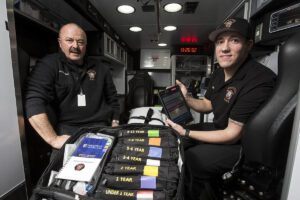The child weighs 48 pounds. He’s 6.
How much naloxone does he need?
It’s a fictional example of a math problem that doesn’t come up often for Mukilteo aid crews. But when it does, it’s not an ideal time to be doing long division.
“You’re trying to remember your drug doses at 3 o’clock in the morning,” said Larry Hadland, medical services officer for the fire department. “Every time it’s a baby or a child, the stress factor quadruples. Everybody’s kind of on edge. It’s easy to make mistakes when you’re like that.”
Now an iPad app, called Handtevy, will do the math and other tricks to help prevent medical errors when treating children.
The app is a digital update to the longtime industry standard, the Broselow tape, where paramedics measure their younger, smaller patients from head to toe with a kind of rainbow color-coded ruler. The colored bars on the measuring tape tell an ambulance crew how much of a certain drug to give the patient.
The tape works, but it has its flaws. Some kids are wider or thinner than others. It’s easy to scan across the width of the Broselow tape, misread a dosage and give a patient, say, 10 times the amount of a stimulant prescribed in a cardiac arrest, said Vincent Schweitzer, a paramedic in Snohomish County for the past 39 years.
And the app is just faster and more accurate, according to promotional videos by the Florida emergency physician, Dr. Peter Antevy, whose company created Handtevy.
Schweitzer spent 200 hours working with Antevy’s team, tweaking the software so it would be in line with medical standards in Snohomish County.
Based on a child’s age and estimated weight, it tells paramedics how a drug should be administered — vein, muscle, bone, nose — as well as how much and how often. The iPhone or iPad app records which drugs were used and when. Once the ambulance reaches the emergency room, data is transferred to the doctors, with time-stamps of when things happened. Medical staff can double-check how pre-hospital treatment was handled, to ensure everything went smoothly, or if, in the rush of the emergency, a dose of something was missed.
It’s a leap forward from the methods of the 1980s.
“We would have to do math on paper, to figure out drip rates and concentrations and ideal weight on patients,” Schweitzer said.
Once you’ve treated enough adults for cardiac arrest, you probably know the suggested dose of ephedrine by heart. With children, that luxury isn’t there, Schweitzer said. And those tend to be high-risk, critical calls.
“You might only see two or three babies a year,” he said. “It’s so few and far between, you just don’t remember.”
The system, along with the medical bags and books that came with it, cost less than $2,000, according to the fire department. In the past month, ambulances at both fire stations were outfitted. The city’s firefighters have iPads, too, and can access the app anytime.
Already it has been used on several non-critical calls, with positive results, Hadland said.
“We no longer use pens and papers, and nobody’s looking at their watch,” he said. “Those days are gone. We live in a digital, electronic world now.”



 Capt. Dan Harbeck (left) and firefighter Eric Shaeffer of the Mukilteo Fire Department hold a new Handtevy kit which utilizes an iPad application to help calculate accurate medicine dosages for children. (Andy Bronson / The Herald)
Capt. Dan Harbeck (left) and firefighter Eric Shaeffer of the Mukilteo Fire Department hold a new Handtevy kit which utilizes an iPad application to help calculate accurate medicine dosages for children. (Andy Bronson / The Herald)